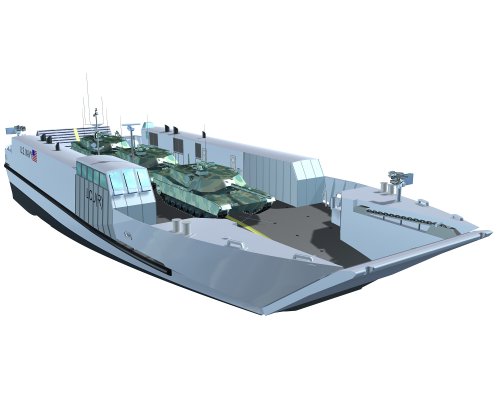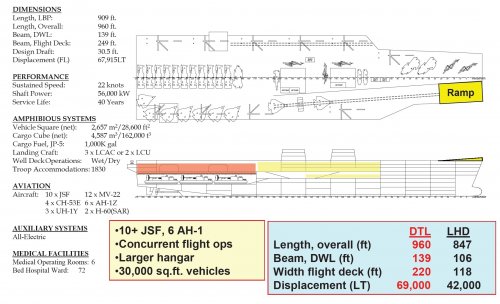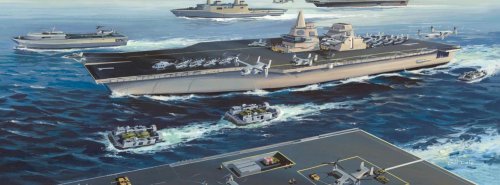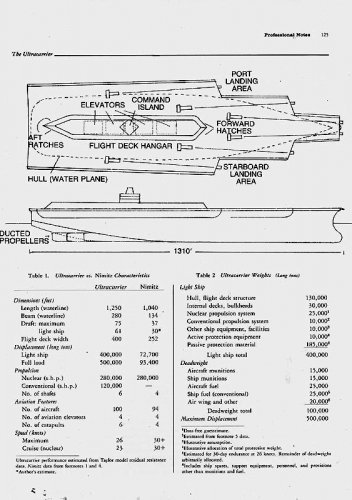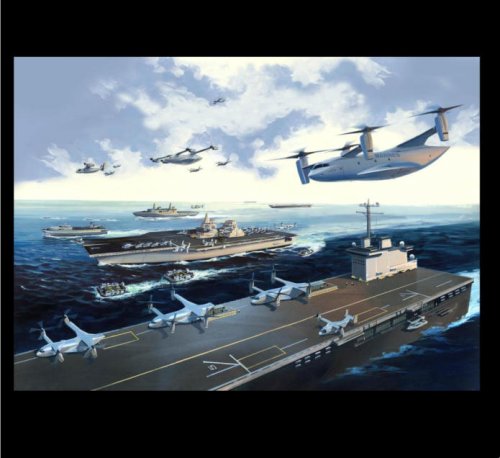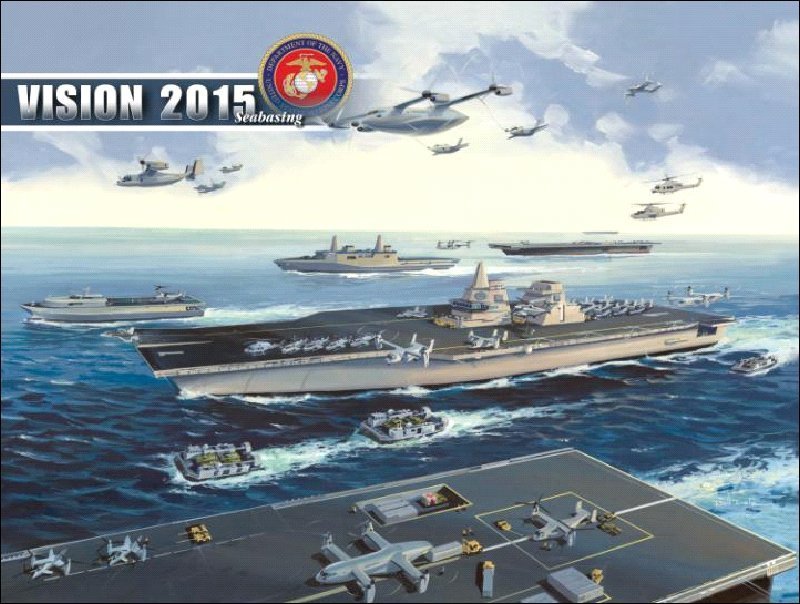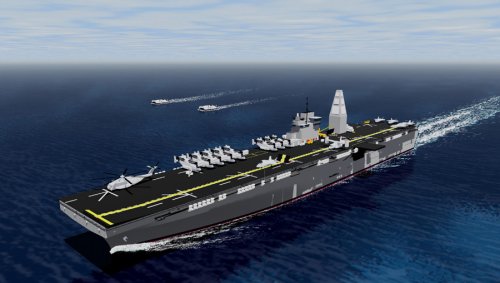You are using an out of date browser. It may not display this or other websites correctly.
You should upgrade or use an alternative browser.
You should upgrade or use an alternative browser.
US LHA(R) designs.
- Thread starter Sferrin
- Start date
Grey Havoc said:A couple of images of a scratchbuilt model of the 1979 Heavy Assault Ship proposal. Originally found here.
What is a good source for additional information on these Iowa-class conversion proposals? I presume that this conversion would have the designation BBH for battleship helicopter.
Bgray
I really should change my personal text
- Joined
- 1 February 2012
- Messages
- 78
- Reaction score
- 24
Hybrid Warships is a good source: http://www.amazon.com/Hybrid-Warship-Amalgamation-Guns-Aircraft/dp/1557503745
Their are also a number of articles in Proceedings, I think mostly in the 1980's that talked about it.
Their are also a number of articles in Proceedings, I think mostly in the 1980's that talked about it.
Bgray said:Hybrid Warships is a good source: http://www.amazon.com/Hybrid-Warship-Amalgamation-Guns-Aircraft/dp/1557503745
Their are also a number of articles in Proceedings, I think mostly in the 1980's that talked about it.
Thank you
In 1979 the Navy proposed reactivating the Iowa Class under a two-phase program. Under Phase I the battleships would be brought back into service quickly with a minimum of new modifications. This was done, and all four ships rejoined the fleet. The initial plan also envisioned a Phase II, under which the aft turrent was to be deleted and a hanger and flight deck added in its place. The hanger would accomodate 12 AV-8B Harrier STOVL jumpjets. The Martin Marietta version for Phase II had a V-shaped flight deck with two ski jumps on the forward edges, on either side of the main superstructure. The flight decks would measure 330 feet by 150 feet. However, by 1984 the plans for these "Battlecarriers" had been dropped.
Source:
http://www.globalsecurity.org/military/systems/ship/bb-61-av.htm
Bgray
I really should change my personal text
- Joined
- 1 February 2012
- Messages
- 78
- Reaction score
- 24
I think teh problem was two fold-- firstly, balance issues made modifying the ships a bit harder than just pulling off the aft turret and putting on a helo deck. That was a major change in the weight distribution.
The other problem was more simple-- the Marines liked the idea of the big guns on the ships-- and so weren't real thrilled with the idea of losing some of them for a helo deck that honestly, they had no lack of.
The other problem was more simple-- the Marines liked the idea of the big guns on the ships-- and so weren't real thrilled with the idea of losing some of them for a helo deck that honestly, they had no lack of.
- Joined
- 9 October 2009
- Messages
- 21,979
- Reaction score
- 13,645
Jazz originally posted these over on the Bell and VT Hovercraft concepts 1960-0nwards thread:


US Assault ship concept 1978
US- Bell Amphib Assault LC 1973
US Assault ship concept 1978
- Joined
- 9 October 2009
- Messages
- 21,979
- Reaction score
- 13,645
A short 2005 presentation called 'LHA(R) Cargo Handling System Trade Study Models'.
- Joined
- 9 October 2009
- Messages
- 21,979
- Reaction score
- 13,645
A CBO report from 1989 titled 'Moving the Marine Corps by Sea in the 1990s. A Special Study'.
- Joined
- 9 October 2009
- Messages
- 21,979
- Reaction score
- 13,645
A 1994 proposal for the timesharing of the USN's Operational Reserve Carrier (USS John F. Kennedy) with the USMC: www.dtic.mil/dtic/tr/fulltext/u2/a283475.pdf
At H-hour on D-day, when it is time for the "grunts" to "kick in the door" with an amphibious assault, USMC Tactical
Aviation (TacAir) must be in position, ready to counter enemy air and provide Close Air Support (CAS). While the Corps'
TaWAi awaits the securing of a Naval Expeditionary Air Field (NEAF) or other such battlefield-proximate airfield ashore,
they must in the interim, have an effective base from which to operate. Friendly air bases too distant from the ground
forces adversely impact the Corps CAS effectiveness. The Corps' TacAir must have a carrier deck, within the
Amphibious Ready Group (ARG), from which to operate from during an operations early phase. The USS John F.
Kennedy (CV-87) is slated for service as an Operational Reserve Carrier (ORC). She as an existing asset, certain to have
ample availablity and capability beyond the Naval Air Reserve and Training Command missions. Double hatting" CV-67
in a dual role, serving both USMC and USNR TacAir, would double her contribution to defense and in so doing, satisfy a
sorely needed capability not available from any other source. During peacetime, the ORG would serve the tranirng
needs of both USMC and USNR TacAir as well as fuliil various other assignments. During crisis, the ORG would
transport, support, and operate USMC TacAir as an integral part of a Marine Air-Ground Task Force (MAGTF). The TacAir
portion of the USMC Air Combat Element (ACE) would operate from CV-67 until the opportunity would allow the ACE to
disembark to a captured airfield or established NEAF. Meanwhile, if moblized, the USNR Air Wing would prepare for
deployment. CV-67 would then embark the USNR Air Wing and redeploy as tasked.
- Joined
- 9 October 2009
- Messages
- 21,979
- Reaction score
- 13,645
No so much a concept, more of an option floated by the Congressional Research Service back in December 2006:
http://www.dtic.mil/dtic/tr/fulltext/u2/a467382.pdf
Implications for Procurement Costs of Other Ships
Naval Reactors estimates that building a nuclear-powered amphibious assault
ship every three years or so could reduce the procurement cost of each nuclear powered
carrier (CVN) by about $65 million and each nuclear-powered attack
submarine (SSN) by about $20 million due to increased economies of scale in the
production of nuclear propulsion components. Naval Reactors further estimates that
if nuclear-powered surface combatants were then added to this mix of nuclear powered
ships, it would reduce the cost of each CVN by an additional $80 million
or so, and each SSN by an additional $25 million or so. Naval Reactors also states
that the additional work in building nuclear-propulsion components could help
stabilize the nuclear-propulsion component industrial base by providing extra work
to certain component makers whose business situation is somewhat fragile.56
If nuclear-powered amphibious assault ships or surface combatants are built
partially or entirely by the two nuclear-construction yards — Northrop Grumman
Newport News (NGNN) and General Dynamics’ Electric Boat division (GD/EB); see
discussion below — it might further reduce the cost of CVNs and SSNs built at those
yards by spreading the fixed overhead costs at those yards over a wider workload and
enabling more efficient rollover of workers from one ship to another. By the same
token, it might increase the cost of other ships being built at Ingalls and GD/BIW by
having the obverse effects in those yards.
Implications for Construction Shipyards
Large-deck amphibious assault ships are currently built by the Ingalls shipyard
that forms part of Northrop Grumman Ship Systems (NGSS), and large surface
combatants are currently built by Ingalls and General Dynamics’ Bath Iron Works
(GD/BIW). These yards, however, are not certified to build nuclear-powered ships.
Shifting amphibious assault ships or large surface combatants from fossil-fuel
propulsion to nuclear-propulsion might therefore shift at least some of the
construction work for these ships away from these yards and toward one or both of
the nuclear-construction yards.
If Ingalls or GD/BIW do not become certified to build nuclear-powered ships,
then future nuclear-powered amphibious assault ships or nuclear-powered large
surface combatants might be partially built by Ingalls or GD/BIW. Under this
scenario, non-nuclear portions of the ships would be built by Ingalls or GD/BIW,
while the reactor compartment would be built by NGNN or possibly GD/EB. Naval
Reactors is currently uncertain whether final assembly would occur at NGNN or at
the yard that built the non-nuclear portions of the ship.57
Alternatively, if Ingalls (which built nuclear-powered submarines until the early
1970s at its East Bank facility) or GD/BIW became certified to build nuclear powered
ships, then future nuclear-powered amphibious assault ships or nuclear powered
large surface combatants could be built entirely at Ingalls or GD/BIW.58
Implications for Ship Maintenance
Shifting large-deck amphibious assault ships or large surface combatants from
fossil-fuel propulsion to nuclear-propulsion would shift some portion of the
maintenance work for these ships away from non-nuclear-certified yards and toward
the nuclear-certified yards, which include NGNN, GD/EB, and the four government operated
naval shipyards.
Implications for Port Calls and Forward Homeporting
Shifting large-deck amphibious assault ships or large surface combatants from
fossil-fuel propulsion to nuclear-propulsion might make them potentially less
welcome in the ports of countries with strong anti-nuclear sentiments. The Navy
works to minimize this issue in connection with its CVNs and SSNs, and these ships
make calls at numerous foreign ports each year. Given their occasional need for
access to nuclear-qualified maintenance facilities, shifting large-deck amphibious
assault ships or large surface combatants from fossil-fuel propulsion to nuclear propulsion
might reduce the number of potentially suitable locations for forward homeporting
the ships, should the Navy decide that forward homeporting them would
be desirable for purposes of shortening transit times to and from operating areas. The
Navy plans to homeport the George Washington (CVN-73) at Yokosuka, Japan, the
Navy’s principal forward homeporting location, in 2008. In light of this decision,
Yokosuka might be suitable as a potential forward homeporting location for nuclear powered
amphibious assault ships or surface combatants
56 Telephone conversation with Naval Reactors, March 24, 2006.
57 Ibid.
58 At an April 6, 2006, hearing before the Projection Forces Subcommittee of the House
Armed Services Committee, Representative Gene Taylor asked how long it might take for
a shipyard to become certified to build a nuclear-powered ship. One witness — Dr. Norman
Friedman — replied that he thought the process might take three or four years. Another
witness — Ronald O’Rourke — noted that in addition to the regulatory steps involved, an
additional potential issue for yards seeking to become nuclear-certified could be local
political support for the idea. Dr. Friedman stated that, in the case of Ingalls, this likely
would not be a significant issue.
http://www.dtic.mil/dtic/tr/fulltext/u2/a467382.pdf
- Joined
- 9 October 2009
- Messages
- 21,979
- Reaction score
- 13,645
http://www.dtic.mil/dtic/tr/fulltext/u2/437828.pdf
PREFACE
This study was conducted for the Office of Naval Research, Washington,
D.C., under Contract No. Nonr-4194(00). Mr. Absalom Simms, Assistant
Director of the Advanced Warfare Systems Division (ONR Code 493), Naval
Analysis Group, was the Project Officer. The study was requested by the
Office of Naval Research as one of several preliminary assessments of
technological developments relating to future weapons systems for amphibious
warfare. These technological assessments, conducted by a number of different
contractors, are intended as input studies to a larger ONR study
of amphibious operations in the 1975-1980 time period.
The research was conducted by the Southern California Laboratories
of Stanford Research Institute and by the Western Division of M. Rosenblatt
& Son, Inc., Naval Architects and Marine Engineers, under subcontract to
the Institute. Dr. Irving Dow, Manager of Research Operations, Economics
Research, at the Institute's Southern California Laboratories was project
leader. George Mitchell was a key member of the project team, and
Dr. George Brinton also contributed to the study. Mr. Ephraim Kaufman,
Manager of the Western Division, was responsible for the work conducted
by M. Rosenblatt & Son, Inc. Mr. Stephen Halpern, Chief Engineer of the
Western Division of that organization, made significant contributions to
the project.
Artist's impression of LHA(R) dual tram line
Source:
https://sites.google.com/site/sanbales2/research
Image removed over redundancy and bandwidth usage concerns
Source:
https://sites.google.com/site/sanbales2/research
Image removed over redundancy and bandwidth usage concerns
Hot Breath
I really should change my personal text
- Joined
- 11 March 2014
- Messages
- 196
- Reaction score
- 12
What were the airflow characteristics around the centre island going to be like? Surely that would complicate air operations in anything but the calmest conditions?
- Joined
- 11 March 2006
- Messages
- 8,625
- Reaction score
- 3,807
I'm not sure, that turbulences on either side of the island would be more severe, than those
on the left-hand side of a "conventional" carrier. At least one side always would have been alee.
on the left-hand side of a "conventional" carrier. At least one side always would have been alee.
- Joined
- 18 March 2008
- Messages
- 3,529
- Reaction score
- 985
The airflow 'burble' (the 'technical' term) would not be an issue because these LHAs would only have aircraft landing on by vertical landing. During which they would be approaching the carrier from outside the burble and also if they were imapcted by this turbulence it would have less effect on their vector than a conventional landing.
Abraham Gubler said:The airflow 'burble' (the 'technical' term) would not be an issue because these LHAs would only have aircraft landing on by vertical landing. During which they would be approaching the carrier from outside the burble and also if they were imapcted by this turbulence it would have less effect on their vector than a conventional landing.
Would the airflow 'burble' have been an issue for Donald Fort's ultracarrier proposal from 1978 in which the ship had a center island with hanger elevators underneath?
Attachments
- Joined
- 11 March 2006
- Messages
- 8,625
- Reaction score
- 3,807
Due to the larger islands, the burble may be larger here, too, I think. But if the space to the left or
to the right is used for landing shouldn't make a difference anyway. I haven't heard, that IJN Hiryu
or Akagi had bigger problems with these regards, than other aircraft carriers.
to the right is used for landing shouldn't make a difference anyway. I haven't heard, that IJN Hiryu
or Akagi had bigger problems with these regards, than other aircraft carriers.
- Joined
- 18 March 2008
- Messages
- 3,529
- Reaction score
- 985
Triton said:Would the airflow 'burble' have been an issue for Donald Fort's ultracarrier proposal from 1978 in which the ship had a center island with hanger elevators underneath?
Sorry for the late reply as I’ve only just seen this.
The problem caused by the burble is dependent on two factors: how turbulent it is and does the aircraft landing onto the deck have to fly through it. And on the later does it fly through the burble while flying the final approach to the deck. Where of course flying through turbulent air can change the aircraft’s speed and attitude at the worst possible time.
In relation to the Fort Ultracarrier it has a very large superstructure along the centreline that covers from the elevators. This would create a lot of burble. It can be aerodynamically shaped to smooth out the air flow but its size is still significant. However the ship design has parallel flight decks spaced out from the centreline on its large sponsons. For an aircraft approaching the port landing deck from a typical head on approach to the carrier (offset to port), followed by a sharp left hand turn to line up with the deck it would miss the burble altogether. So no problem. If it was landing onto the other side, ie crossing the stern of the carrier, it would fly through the burble. But it would fly through it during the sharp left hand turn. It might upset the turn a bit but it wouldn’t be in the way on the approach. Doesn’t sound so bad? But many would say it’s that final turn which decides how good the landing is going to be.
But considering some US flight decks like the Midway class with the burble as the aircraft crosses the round down its not so bad. Could be worse!
Triton said:Abraham Gubler said:The airflow 'burble' (the 'technical' term) would not be an issue because these LHAs would only have aircraft landing on by vertical landing. During which they would be approaching the carrier from outside the burble and also if they were imapcted by this turbulence it would have less effect on their vector than a conventional landing.
Would the airflow 'burble' have been an issue for Donald Fort's ultracarrier proposal from 1978 in which the ship had a center island with hanger elevators underneath?
That's an awful big ship to have only a small increase over a Nimitz airwing... what were the supposed advantages of that concept?
- Joined
- 18 March 2008
- Messages
- 3,529
- Reaction score
- 985
gtg947h said:That's an awful big ship to have only a small increase over a Nimitz airwing... what were the supposed advantages of that concept?
Has its own thread:
http://www.secretprojects.co.uk/forum/index.php/topic,6349.0.html
gtg947h said:That's an awful big ship to have only a small increase over a Nimitz airwing... what were the supposed advantages of that concept?
The idea was principally to increase the survivability of a large aircraft carrier so that it could withstand hits that could not be avoided. That's why the ship has 180,000 tons of passive protection. The larger interior space of the ultra carrier could be used to increase hanger space, increase storage for spares and other consumables reducing at-sea replenishment, and increased crew comfort over the existing Nimitz class. Also note the six catapults in the design, armored elevators, and port and starboard landing areas.
Does anyone know why the America class LHA does not have a "ski-jump"?
- Joined
- 3 June 2011
- Messages
- 18,344
- Reaction score
- 12,261
Triton said:Does anyone know why the America class LHA does not have "ski-jump"?
Because the USMC didn't want one. Same reason the Wasps and Tarawas didn't have one.
sferrin said:Because the USMC didn't want one. Same reason the Wasps and Tarawas didn't have one.
"Ski-jumps" are used to place the aircraft in a safer nose-high attitude in case of engine flameout?
- Joined
- 3 June 2011
- Messages
- 18,344
- Reaction score
- 12,261
Triton said:sferrin said:Because the USMC didn't want one. Same reason the Wasps and Tarawas didn't have one.
"Ski-jumps" are used to place the aircraft in a safer nose-high attitude in case of engine flameout?
I think you responded to the wrong post. Yours has nothing to do with mine.
I was asking what the purpose of "ski-jumps" was?
- Joined
- 18 March 2008
- Messages
- 3,529
- Reaction score
- 985
Triton said:"Ski-jumps" are used to place the aircraft in a safer nose-high attitude in case of engine flameout?
Err nope. The ski jump is used to provide the aircraft with a free boost to takeoff thanks to the ramp. The USN doesn't use ski jumps on their LHAs because they have much longer flight decks than most Harrier carriers. So the aircraft has less need for the ramp. Of course the ramp would be better for the aircraft but it consumes flight deck space for helicopter takeoff. So they don't fit ramps.
Abraham Gubler said:Triton said:"Ski-jumps" are used to place the aircraft in a safer nose-high attitude in case of engine flameout?
Err nope. The ski jump is used to provide the aircraft with a free boost to takeoff thanks to the ramp. The USN doesn't use ski jumps on their LHAs because they have much longer flight decks than most Harrier carriers. So the aircraft has less need for the ramp. Of course the ramp would be better for the aircraft but it consumes flight deck space for helicopter takeoff. So they don't fit ramps.
Thank you for the explanation, Abraham. The "nose-high attitude in case of engine flameout" came from Marine: A Guided Tour of a Marine Expeditionary Unit by Tom Clancy.
- Joined
- 18 March 2008
- Messages
- 3,529
- Reaction score
- 985
David Hobbs provides a detailed description of how short rolling takeoffs and ski jump takeoffs work with Harriers (and other aircraft) on page 315 of his book British Aircraft Carriers. The principle behind the ship ski jump is the same as every other ramp used to launch things into the air including well ski jumps.
Would have thought even Tom Clancy should have known that? Maybe he had never heard of Ken Carter?
http://www.youtube.com/watch?v=tpUMSarCSQw
Would have thought even Tom Clancy should have known that? Maybe he had never heard of Ken Carter?
http://www.youtube.com/watch?v=tpUMSarCSQw
Unfortunately, the concept painting came from the website of the artist. There is no documentation accompanying the painting or dates.
- Joined
- 1 April 2006
- Messages
- 11,399
- Reaction score
- 10,321
isayyo2
Lurker alert
- Joined
- 24 November 2011
- Messages
- 1,131
- Reaction score
- 2,331
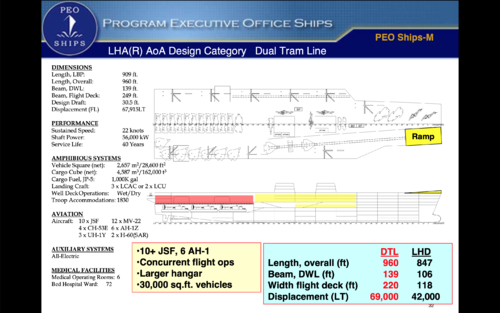
More Dual Tram information and additional slide from the program office: https://docplayer.net/63446110-Peo-ships-brief-to-ndia.html
archipeppe
ACCESS: Top Secret
- Joined
- 18 October 2007
- Messages
- 2,431
- Reaction score
- 3,153
Interestingly within the design is depicted the F-32B rather than the actual F-35B.
Similar threads
-
US Navy Intra-Theater Auxiliary Lift Ship (ITALS)
- Started by Triton
- Replies: 0
-
-
-
-
Cancelled 1950s Aluminum Hull USN Ocean Minesweeper?
- Started by TinWing
- Replies: 9

